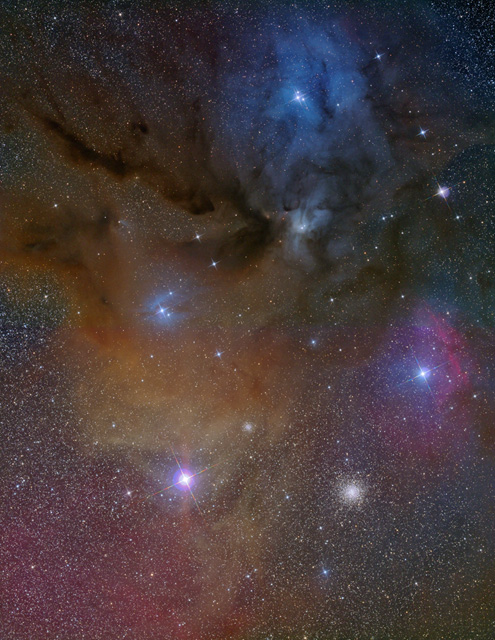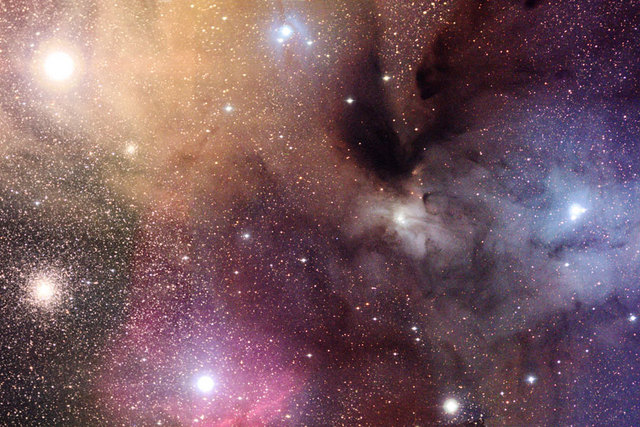| Time Travel Research Center © 2005 Cetin BAL - GSM:+90 05366063183 - Turkey / Denizli | ||||
|
|
||||
|
Rho-Antares Region
|
|||
|
In the Scorpion's Heart... |
||||

THE RHO-ANTARES REGION - WIDE FIELD MOSAIC in SCORPIUS
Credit line - Jay Ballauer, Phil Jones, and Adam Block
|
About this Object: |
|
This area of Scorpius produces the prettiest photographs! The bright yellow star Antares, the heart of Scorpion, produces a curious yellow nebulosity; very rare. That would ordinarily be pretty enough but many other colorful objects adorn this view. Three areas of blue nebulosity appear, most notably around the triple star system of Rho Ophiuchi at the upper right. Another area of blue nebulosity surrounds the triple star system of 22 Scorpi, just above Antares. Between the two triple star systems is IC 4603, itself a pretty blue nebula. Red nebulosity also appears in the area around Sigma Scorpi at the upper right and below Antares itself. The great M4 globular cluster appears just to the right of Antares and another smaller globular, NGC 6144 can be seen right in the middle of everything else. And all this is covered with the dust of dark nebula, such as Barnard 42 in the upper left. Therefore, the images shows every type of nebulosity imaginable; red hydrogen emission nebulae, blue and yellow reflection nebulae, and dark nebulae. In total, this area of colorful dust is quite extraordinary! |
Location:
Kitt Peak National
Observatory near Tuscon, Arizona.
Date: June 2, 2005
Seeing:
3/10
Transparency: 9/10
Temperature: 52 degrees F (-20 degrees C on camera)
Scope/Mount: Tak FSQ-106 @ f/5 and Paramount ME
Camera: SBIG STL-11000M astro CCD camera
Exposure Info: Two frame mosaic, RGB image; 20:20:30 RGB for
each frame (10 minute subexposures all unbinned), processed with synthetic
luminance
Processing
Information:
Calibration (darks, bias, flats),
Registration, gradient removal, and RGB channel combine in MaxIm DL 4 (mean
combine). LRGB combine, mosaic stitching, cropping, color balance, levels/curves,
sharpening, and noise removal in Photoshop CS.
Exposure Notes: String used on the front of the aperture to give the diffraction spikes on the stars. Data was taken by Jay Ballauer, Phil Jones, and Adam Block. Image processing done by Jay Ballauer. Special thanks to Adam Block for hosting Phil and I at the Advanced Observer's Program atop Kitt Peak. Likewise, thanks to the Three Rivers Foundation and Dr. Fred Koch for sponsoring the trip.

Ro Yılancı'nın Renkli
Bulutları
Açıklama : Ro Yılancı içerisinde yer alan bulutların görülmeye değer
farklı renkleri, orada süregelen farklı süreçlere dikkat çekmektedir. Mavi
bölgeler asıl olarak yansıyan ışıkla parlamaktadır. Ro Yılancı ve
yakınlardaki diğer yıldızlardan gelen mavi ışık, kırmızı ışığa kıyasla
bulutsunun bu bölgesinden daha verimli yansır. Gündüzleri Dünya'nın gökyüzü
de aynı sebeple mavi renkte görünmektedir. Kırmızı ve sarı bölgeler ise asıl
olarak bulutsunun atom ve molekül gazından salınan ışımayla parlamaktadır.
Yakınlardaki mavi yıldızlardan gelen ve parlak yıldız Akrep Yüreği (Antares)'ninkinden
daha fazla enerji yüklü olan ışık, gazdaki elektronlara çarparak
uzaklaştırmakta, gaz ise daha sonra elektronlar kendisiyle tekrar birleşince
parıldamaktadır. Koyu renkli bölgeler ise genç yıldızların havakürelerinde
meydana gelen ve arkalarından salınan ışığı etkili bir biçimde engelleyen
toz zerrecikleri nedeniyle ortaya çıkmaktadır. Ro Yılancı yıldız bulutları,
yukarıdaki görüntünün sol alt tarafında görülen küresel küme M4'ün oldukça
önünde yer almakta ve insan gözünün görebileceğinden çok daha fazla renk
içermektedir. Bu bulutlar, radyodan gama ışınına kadar her dalga boyunda
ışık salmaktadır.
Astronomi Nebula Resimler Astrophotography Galaxy Resimler Yıldız kümeleri Resimler
Copyright(c) 2003 - 2005 Cetinbal All rights reserved.